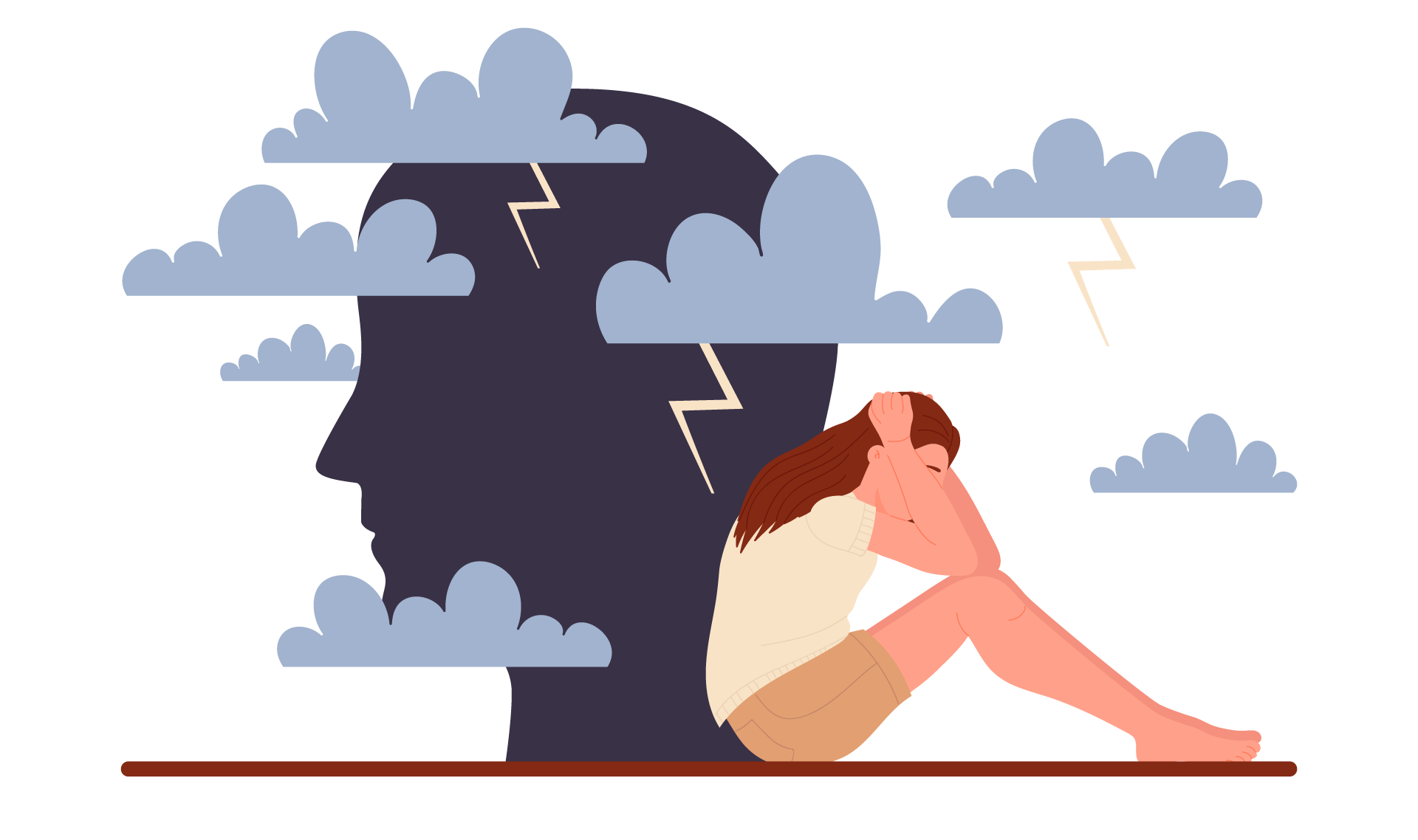Driving anxiety: Learn how you can defeat it and take back control

Have you developed a fear of driving? If so, you may be experiencing something called driving anxiety. Driving anxiety is characterised by fearful thoughts or intense worry related to driving. It can range from mild feelings of discomfort to severe panic attacks. If you experience these feelings, it may be extremely difficult for you to get behind the wheel at all.
According to a recent study, driving anxiety is becoming much more common amongst younger drivers with 62% of those aged under 25 experiencing anxiety while driving. If you feel dread or nervousness every time you get behind the wheel, just know that you are not alone. This is a common issue that affects many people.
We understand that sometimes it’s easier said than done. However, in this blog post we’re going to share some effective tips that you can use to take back control.
Symptoms of driving anxiety

Driving anxiety affects everyone differently. Depending on the individual, symptoms can range from mild to severe. Some of these symptoms can also be associated with generalised anxiety and can include:
- An increased heart rate
- Shortness of breath
- Sweating
- Trembling or shaking
- Nausea
- Dizziness or lightheadedness
- Tightness in the chest
- Fear of losing control
- Excessive worry
- Muscle tension
- Irritability
- Panic attacks
Understanding the cause of driving anxiety

The first step to regaining control and overcoming your fear of driving is to understand the root cause of your driving anxiety. This could be due to a traumatic past event, a lack of confidence or experience on the road or a general anxiety disorder. Having an understanding of the root cause will allow you to effectively address the problem and begin moving forwards.
If you’ve been involved in or witnessed a car accident, it can leave a lasting impact on you. The fear of something similar happening again can trigger feelings of anxiety whenever you get behind the wheel. The fear of being involved in another dangerous situation can be overwhelming. Which can often lead to an increased sense of anxiety while driving.
If not managed effectively, this can then snowball and develop into vehophobia or better known as a driving phobia. Vehophobia is categorised by an intense fear of driving or being a passenger in a car and can cause individuals to avoid driving altogether.
When you’re a new driver, you may have a lack of confidence and feel like you haven’t had enough experience behind the wheel. We want you to know that it’s completely normal to feel this way! The fear of making mistakes or not knowing exactly how to react if a certain situation happened can lead to heightened levels of anxiety. This can also be fuelled further by negative self-talk and the fear of judgement from other drivers.
Why is this important?

If you already struggle with anxiety in other areas of your life, it can easily transfer over to driving. Due to general anxiety, when you’re behind the wheel a fear of driving can be triggered, so it’s crucial to manage this in order to alleviate driving anxiety.
Do these examples resonate with you? If so, the good news is you can now begin to formulate strategies to overcome this We understand that everyone’s experience with driving anxiety is uniquely their own, and what works for one driver may not necessarily work for you. Therefore, finding the right approach and coping mechanism based on your root cause is key to successfully overcoming your anxiety while driving.
Driving anxiety and the DVLA
You must tell the Driver and Vehicle Licensing Agency if you experience a level of anxiety that affects your ability to drive safely else you could face a fine. You may even be prosecuted if you’re involved in an accident as a result of your condition. If you’re unsure if your anxiety will affect your driving, it is best if you consult your doctor. To tell the DVLA if your condition will affect your driving you must fill in a questionnaire and send it to them and can be found here.
Driving anxiety and higher car insurance
Did you know that you could be fined up to £1,000 if you don’t tell the DVLA about a medical condition that affects your driving? With this in mind, you may be wondering if telling your car insurer about your anxiety increases the price of your insurance premium? Well, we’re here to tell you that it doesn’t! According to the AA, your insurance company can’t charge a higher premium or increased excess without evidence that you’re an increased risk on the road.
Find a coping technique for instant relief

Finding a coping technique that can combat your anxiety and that works for you may require some trial and error. If you’re experiencing anxiety while driving and you need instant relief from panic, breathing exercises will be your best friend! Breathing exercises have the power to help you when you’re experiencing feelings of stress or panic while driving. They can assist you in slowing down your heart rate and calming your mind, alleviating the physical symptoms of anxiety. This will then allow you to better control your mind and thus your car.
The most effective breathing technique for instant relief is called diaphragmatic breathing or belly breathing. By focusing on the counting and the rhythm of your own breath, you’re essentially redirecting your attention away from your driving anxiety and towards a calming and controlled activity. Breathing exercises may not completely eliminate driving anxiety, especially if it’s caused by a phobia or generalised anxiety disorder, but it can serve as a helpful tool and can provide instant relief when you’re experiencing anxiety while driving. If you wanted too, you could also incorporate this breathing exercise into your everyday routine (even when you’re not driving). By doing this, you could build a sense of calm and mindfulness in your everyday life.
How to practise diaphragmatic breathing

The first thing you need to do is take a slow, deep breath in through your nose allowing your abdomen to rise as you fill your lungs with air. Next exhale slowly through your mouth, emptying your lungs completely with a focus on bringing your abdomen back towards your spine. Continue with this breathing pattern, inhaling for a count of four and exhaling for a count of four. As you’re doing this, try and let go of any tension or anxiety you may be feeling whilst behind the wheel. Imagine that you are exhaling out all of the negative energy and inhaling calmness and peace. Repeat as necessary.
Coping with a panic attack whilst driving
It can be extremely dangerous if you experience a panic attack whilst you are driving. You must act quickly and take action in order to keep yourself and others safe.
If you notice the first sign of a panic attack, follow these instructions:
- Acknowledge the physical and mental sensations related to a panic attack
- Let others in the car know what to do and how to respond
- Pull over immediately but safely
- Put your hazard lights on to alert other drivers
- Stay in the car to avoid traffic
- Use your coping mechanisms and techniques to help calm yourself.
Building confidence

There are various techniques that will help you build your confidence and overcome your fear of driving, however gradual exposure is what we’re going to focus on in this post. Even though it requires time and patience, it’s a great way in which to build your driving confidence and overcome your fear of driving.
Gradual exposure is done slowly over time, with the overall aim of helping you change your behavioural patterns depending on how severe your driving anxiety is. You start by driving in familiar, low-stress environments with or without someone in the passenger seat and then gradually progressing to more challenging situations. Some examples of challenging driving situations include different weather conditions, busier times of day or unfamiliar routes. This will not only increase your confidence significantly, but it will slowly start expanding your comfort zone and help you to see driving as a more enjoyable experience. It may help you to consider each experience on the road (the good, the bad and the ugly) as an opportunity for growth and a chance to put into practice your newfound coping techniques.
Lifestyle changes

Nobody should have to experience feelings of dread when getting behind the wheel. By making certain small lifestyle changes that are known to help reduce anxiety, your efforts to reduce driving anxiety will be reinforced. Some of the most effective ways to reduce general anxiety that you can start right now include engaging in regular physical activity, prioristing sleep, maintaining a healthy balanced diet and limiting caffeine intake.
When you exercise you release endorphins which are natural mood-boosting chemicals in the brain, it also helps improve your sleep which is crucial for anxiety regulation. Lack of sleep can increase stress levels and make you more prone to anxious thoughts and feelings. Additionally, the food that you eat can have a significant impact on your mental well-being. Try to incorporate a balanced diet consisting of fruits, vegetables, whole grains, lean proteins, and healthy fats. Avoid or minimise consumption of processed foods, refined sugars, caffeine, and alcohol, as these can exacerbate anxiety symptoms. Whilst many people rely on caffeine to help them stay alert, excessive consumption can trigger anxiety symptoms. Caffeine stimulates the nervous system, increasing heart rate and potentially causing jitters and feelings of restlessness. Instead, opt for decaffeinated drinks or herbal teas that promote relaxation, such as chamomile or lavender tea.
Practising stress management techniques and incorporating them into your everyday routine can also reduce overall stress and anxiety levels. These techniques can include mindfulness meditation, deep breathing exercises, progressive muscle relaxation, or engaging in hobbies that promote relaxation.
It’s worth noting, whilst these changes may not eliminate driving anxiety entirely, they can provide significant relief and improve your overall well-being. Allow yourself some room for setbacks and attempt to connect with or establish a support system as this can provide comfort and reassurance when it’s needed.
Seek specialised help if required

While self-help strategies can be effective in managing driving anxiety, there may be instances where seeking professional help is necessary. Is your driving anxiety is severely impacting your daily life? Is it preventing you from driving altogether or causing intense panic attacks? If so, it’s important to reach out to a mental health professional for guidance and support. A therapist experienced in anxiety disorders can help you explore and develop personalised coping strategies and can provide a safe space for you to discuss your fears and concerns. Additionally, they can guide you through evidence-based therapies, such as cognitive-behavioural therapy (CBT).
Seeking professional help is a courageous step towards improving your mental well-being and taking control of your life. You don’t have to face driving anxiety alone, and there are plenty of resources available to support you every step of the way!
What if I can’t overcome my driving anxiety?

Overcoming driving anxiety is a gradual process. Statistics show that feelings related to driving anxiety largely fall over time, with just 22% of drivers aged 65 plus saying they suffer from the condition. We understand how frustrating it can be if the fear of driving persists; however, you must approach the challenge with patience and a commitment to finding solutions that work for you. You may want to consider exploring alternative transportation options that can offer a temporary reprieve while you work on addressing getting over your fear of driving. It’s a journey, and progress may come in small steps.
Just remember, always be compassionate with yourself, celebrate victories, and know that with time and effort (and our expert guidance), it’s possible to build a more confident and comfortable relationship with driving!
